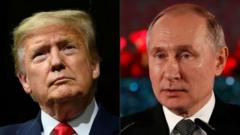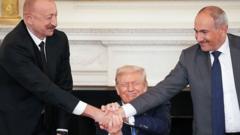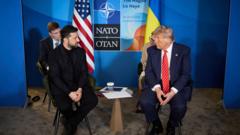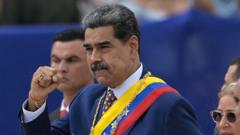Despite declining oil revenues and a slowing economy, Russia maintains a level of resilience against U.S. economic sanctions imposed by President Trump. With military spending protected and a cautious consumer base, the Kremlin shows no signs of altering its strategy in Ukraine.
Economic Resilience: Russia's Response to Trump's Sanctions Threats Amid the Ukraine Conflict

Economic Resilience: Russia's Response to Trump's Sanctions Threats Amid the Ukraine Conflict
As President Trump applies new economic pressures on Russia to end its conflict in Ukraine, analysts weigh the Kremlin's ability to withstand these challenges amid a shifting economic landscape.
In a strategic confrontation with U.S. President Trump, who has recently escalated economic threats against Russia in an attempt to force a halt to its ongoing conflict in Ukraine, the Kremlin appears resolute. Trump has suggested meeting with President Vladimir Putin while simultaneously announcing punitive measures against India for purchasing Russian oil. This dual approach underscores the complexity of international relations and trade during wartime, particularly focusing on Russia’s economic standing.
Historically, Russia has responded to international sanctions by bolstering its military spending. Current economic forecasts indicate a modest growth rate of 1 to 2 percent for 2025, a significant drop from the 4.7 percent recorded in 2024. This downturn is attributed primarily to diminishing oil revenues; data reveals a staggering 18 percent decline this year due to falling global oil prices as well as higher interest rates that have stunted private investments. Large Russian enterprises are facing a dilemma as investment projects dwindle, exacerbating economic stagnation.
Despite these challenges, the government has taken steps to counterbalance the slowdown, which some policymakers argue could offer a more stable economic environment. Inflation rate is currently hovering around 9 percent annually, with high-interest rates at 18 percent. Interestingly, these economic parameters have not yet substantially undermined living standards for many Russians; a recent report claims that current living conditions are the most favorable they have been in over a decade, aided by rising wages outpacing inflation.
However, the persistent dependence on oil revenue remains a significant vulnerability for the Russian economy. With the Russian government recently escalating budget deficit projections from 0.5 to 1.7 percent of gross domestic product (GDP), the strategies to mend this gap involve tapping into the sovereign wealth fund and reducing social spending. Notably, military expenditures have remained sacrosanct, constituting approximately 8 percent of GDP, signifying that defense priorities remain intact.
On the diplomatic front, Trump has threatened to take extensive measures, particularly targeting India's oil imports from Russia. India’s status as one of the largest buyers of Russian oil complicates these sanctions, as officials have signaled their intention to continue sourcing Russian crude, despite potential tariffs. This dynamic raises questions about the efficacy of Trump's economic strategies to impact Russian military operations.
Analysts remain divided on the potential outcomes of Trump’s pressure tactics. While a decline in oil revenues could further strain the budget, it may not suffice to curtail Putin’s military ambitions. According to experts, even if Trump achieves a drop in oil prices, the Kremlin appears confident in its ability to sustain military operations despite fiscal challenges.
The ongoing interactions paint a convoluted picture of international relations, highlighting the balance of economic motivations and the geopolitical landscape that continues to shape the Russia-Ukraine conflict. As both sides navigate this complex scenario, the path forward remains uncertain, with the possibility of shifting alliances and continued military engagements.


















